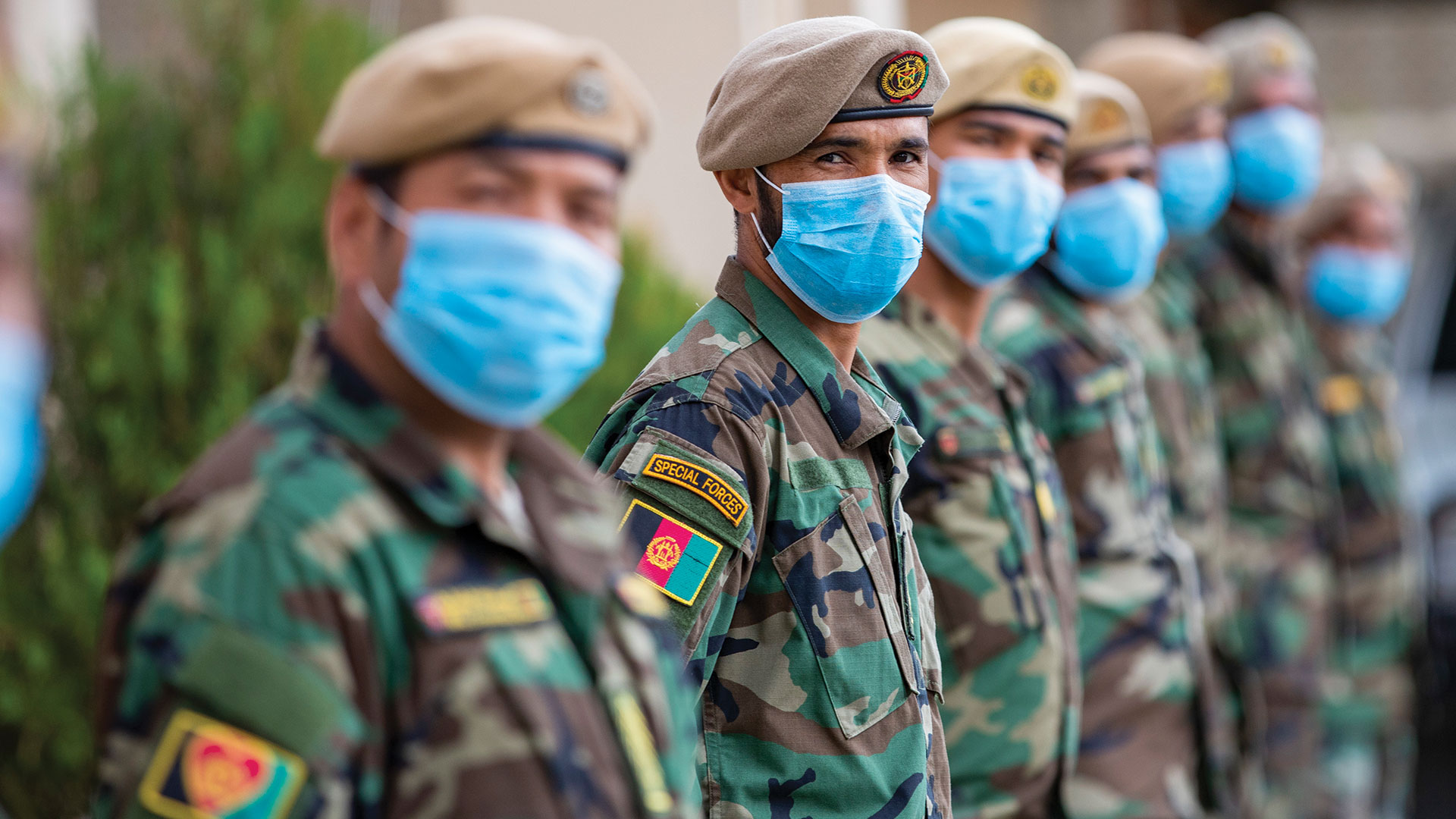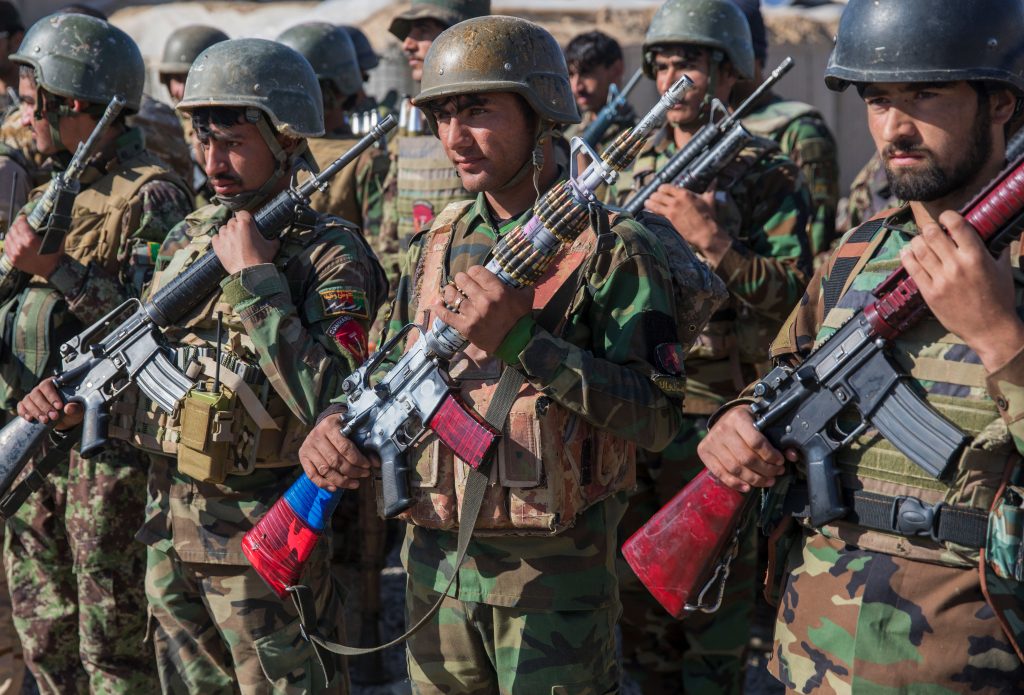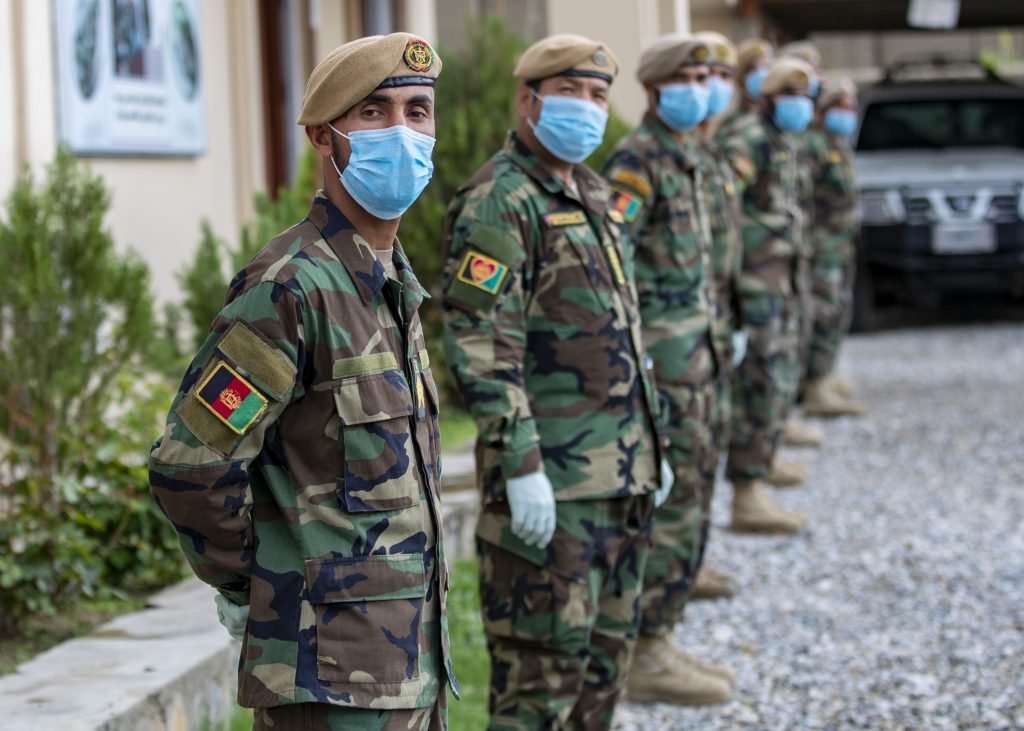
Afghanistan to receive more than a million ventilator masks, gowns and gloves
by Adriane Elliot
Neither a global pandemic nor a pending troop withdrawal has halted U.S. support to Afghanistan.
Over a million respirator (N95) and surgical masks, surgical gowns, gloves and accessories are being shipped to the Afghan National Army (ANA) as part of two pseudo foreign military sales (FMS) cases subsidized by Overseas Contingency Operations funding. The multiple-shipment delivery will be phased out through December 2021. For those unfamiliar, pseudo FMS cases are financed through the DOD and various legal authorities to be spent on the acquisition of defense materiel or services that will subsequently be turned over to another nation. The pseudo-case method tracks the expenditure of these appropriated funds.
This delivery is especially important during a pandemic when critical supplies can be scarce, but this and other types of security assistance is nothing new for the U.S. Army Security Assistance Command (USASAC). Executing security assistance and FMS with partner nations has many benefits—for U.S. national security, our armed forces and for our allies across the globe. It enhances political-military ties and regional stability, helps deter aggression and promote democratic values, supports combatant command goals and objectives, reduces production costs and keeps industry production lines “hot”; it also enhances defense industry interest of both nations and decreases U.S. deployments as our partners are able to defend their own borders. Currently, USASAC manages over 6,500 FMS cases—worth more than $205 billion—for over 140 countries.
“But USASAC’s mission is not about the money, it’s about real-world impact—well equipped and ready allies,” said Dr. Myra Gray, USASAC’s deputy to the commanding general.
Examples of FMS cases that result in a tremendous fortification of our allies include—among others—the High Mobility Artillery Rocket Systems and Patriot Advanced Capability missiles in Poland, Kiowa helicopters in Greece and Stryker command vehicles in Thailand.
“Because while we must be capable of fighting and winning on our own, we are stronger and more formidable when we can rely on partner nations and allies to stage, support, maneuver, and execute the fight together,” Gray said. “Strengthening alliances is key to the National Defense Strategy, and our Army leadership continues to reinforce allies and partners as a priority. From increased interoperability on the battlefield to partner agreements that enable freedom of movement and maneuver, our allies and partners will be critical to deter war, and, if necessary, fight and win war.”

Afghan National Army soldiers stand in afternoon formation awaiting instructions at a checkpoint in western Afghanistan, Dec. 31, 2019. (U.S. Army Reserve photo by Spc. Jeffery J. Harris/ Released)
“The FMS mission at USASAC enables the Army’s ability to mobilize, deploy, and sustain forces in large-scale combat operations, making sure that when we get ready to go to war the next time, we’ve got capable and ready partners,” she said.
This recent shipment of trauma center supplies to Afghanistan totaled $1.7 million and is a timely reminder of the U.S.-NATO commitment to train, advise and assist Afghan security forces, according to Wade Preston, CENTCOM division chief for the U.S. Army Security Assistance Command (USASAC). “After officially transitioning from a combat role to a support role in early 2015, the U.S. has continued to provide everything from equipment, supplies and services to training, infrastructure repair and funding. Afghanistan is a Major non-NATO ally,” explained Preston, “making these types of security assistance missions a critical component of U.S. foreign policy. That really is the crux of the security assistance mission–we help strengthen our allies, so that our allies are well-equipped, capable and ready. They’re able to bear their share of the global burden,” said Preston, who has executed FMS cases at USASAC for over a decade.
“The U.S. Army has to be capable of fighting and winning on its own, but we are stronger and more formidable when we can rely on our partners to stage, support and execute the fight together,” said Preston. “All over the globe, we rely on these partners for the use of their terrain, ports, airfields and critical infrastructure that, if and when the time comes, will help speed our troops to the front lines.” He believes this is the reason Army leadership continually reinforces allies and partners as a priority.

Afghan National Army Commandos stand in formation waiting to be greeted by Afghan Minister of Defense Asadullah Khalid and Resolute Support Commander Gen. Scott Miller in Kabul, Afghanistan, April 28, 2020.
As for the U.S.-Afghanistan partnership, Preston said Afghanistan remains a vital partner of the U.S. in the fight against terrorism. The intra-Afghan peace negotiations, which kicked off in Qatar on Sept. 12, 2020, are a historic opportunity for peace in the ongoing war in Afghanistan. The peace talks began 19 years and one day after the 9/11 terrorist attacks on the United States, and are the first direct talks between the Afghan government and the Taliban.
A peaceful settlement to the ongoing war in Afghanistan could end America’s longest conflict. Few knew when it started that it would outlast the Civil War, Spanish‐American War, World Wars I and II, and the Korean War combined. And few could have predicted that the U.S. military would recruit Soldiers to fight a war that started before they were born.
The cost of America’s longest war has been high, claiming the lives of than 2,300 U.S. troops, trillions of dollars and countless casualties in Afghanistan and throughout the NATO ranks.

Afghan National Army soldiers stand in formation waiting to be greeted by Afghan Deputy Defense Minister Dr. Yasin Zia and Resolute Support Commander Gen. Scott Miller at a checkpoint in western Afghanistan Dec. 31, 2019.
“It’s a good day to reaffirm our support for the Afghan Security Forces as well as the people of Afghanistan. It’s a very good time for all sides to consider reducing violence so the military forces of all sides can build the political path to peace,” said Resolute Support Commander Gen. Austin Scott Miller during an Aug. 18 video message wishing the Afghan people a happy Independence Day.
As the United States and NATO urge the Afghan government and the Taliban towards a definitive peace deal, they remain committed to training and funding the Afghanistan’s security forces and institutions, in hopes the country will never again serve as a haven for terrorists.
For more information about USASAC and its support to Afghanistan and more than 140 countries around the globe, visit www.army.mil/usasac.
ADRIANE ELLIOT has served as a journalist, editor and public affairs specialist for the U.S. Army for more than 24 years, both on and off active duty in the U.S., Europe, Asia and the Middle East. Before beginning her military public affairs career, she served as a freelance reporter and columnist for the New Bern Sun Journal tri-county newspaper in New Bern, N.C. She served as the director of public affairs for the Area Support Group-Afghanistan during a yearlong deployment in support of Operation Freedom’s Sentinel and the ongoing NATO-led Resolute Support Mission. She is the recipient of multiple military and national civilian journalism competition awards.
Read the full article in the Winter 2021 issue of Army AL&T magazine.
Subscribe to Army AL&T News – the premier online news source for the Army Acquisition Workforce. ![]() Subscribe
Subscribe







